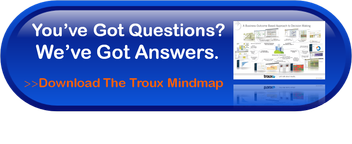Beware the Barbarians at the Gate

 Despite its somewhat rocky start, Enterprise Architecture is now often referred to as a burgeoning field. With its origins dating back to the 60s, perhaps EA was ahead of its time when it emerged as framework used to optimize systems and technology for the business. Today, as information moves to the cloud, datacenters become defined by software, and mobile devices take over the world, that primary goal for EA initiatives has become front and center.
Despite its somewhat rocky start, Enterprise Architecture is now often referred to as a burgeoning field. With its origins dating back to the 60s, perhaps EA was ahead of its time when it emerged as framework used to optimize systems and technology for the business. Today, as information moves to the cloud, datacenters become defined by software, and mobile devices take over the world, that primary goal for EA initiatives has become front and center.
Businesses not only need to ensure they are fully optimized for the here and now, but they need to be prepared to make rapid changes and keep up with the pace of the future. Enterprise Architecture can help companies visualize how to make that happen and spotlight the decisions that need to be made to get there. That, I think we can all agree on.
As a result of the recent proliferation of personal technology, the rise in self-service models and the evolution of digital services we have all become technology “experts.” Technology is no longer strictly the domain of the IT department, as every function of the business uses it and everyone wants a say in the decisions that are made surrounding it. This has sparked an ongoing debate about who should now “own” the practice of EA. On the IT side, there is a lot of techy stuff to figure out and it only gets more complex as the pace of innovation accelerates. On the business side, technology now has a significant impact on results and the argument can be made that EA should live with the business decision makers.
As Arthur Cole mentions in his recent post for ITBusinessEdge, for IT, the barbarians are at the gate. Where once there was no question that business decisions should be made at the C-level and these technology decisions should be left up to the tech professionals, there are many reasonable arguments for people across the business to have their seat at the EA table.
Perhaps this shouldn’t be a debate at all. There are a lot of good points being made on both sides of the argument – but when it all nets out – meaningful decisions no longer affect one part of the enterprise. The enterprise is now connected – it is no longer adequate to live with labels of the past, thinking of IT and the Business as separate entities with different agendas. Now, more than ever it is important for stakeholders across the connected enterprise to realize that – EA is free – everyone owns it.
Businesses are and will continue to struggle with seeing through the complexity to make well-informed decisions… at any level. A proper EA program can equip decision makers with the most comprehensive view of their business and provide them with the ability to better understand the impact of change, cost of change and benefit of change across the connected enterprise. Gaining this visibility before developing and implementing a plan for change is what should be driving the discussion in the corner offices – not where EA should live.
The sooner business leaders embrace EA as a routine part of their decision making process the better – for all parties involved. When done right, EA enables the enterprise to define better strategies and ensure better execution. Better decisions and better execution deliver better results. Again, something we can all agree on!
Learn how the California Department of Corrections and Rehabilitation worked with Troux to reduce complexity, control costs and speed decision-making through alignment of Business and IT: http://resources.troux.com/cdcr


.jpg) No doubt about it, Big Data is big business. Big Data has certainly captured the imagination and wallets of business executives everywhere. In fact, Gartner estimates that Big Data drove $34 billion in worldwide IT spending last year.* With that kind of money being spent, it’s probably safe to say Big Data is a big deal.
No doubt about it, Big Data is big business. Big Data has certainly captured the imagination and wallets of business executives everywhere. In fact, Gartner estimates that Big Data drove $34 billion in worldwide IT spending last year.* With that kind of money being spent, it’s probably safe to say Big Data is a big deal.
 Organizations big and small are getting comfortable with the idea of having business applications run in the cloud. It’s now common and even standard for new software and applications to be consumed as a service. But when it comes to moving mission critical legacy apps to the cloud, a lot more is at stake. Is anyone really ready? There will be a point when this shift happens, as it is already in motion for many organizations, and business leaders need to understand the implications that come along with making the heavy decision to lighten up with cloud.
Organizations big and small are getting comfortable with the idea of having business applications run in the cloud. It’s now common and even standard for new software and applications to be consumed as a service. But when it comes to moving mission critical legacy apps to the cloud, a lot more is at stake. Is anyone really ready? There will be a point when this shift happens, as it is already in motion for many organizations, and business leaders need to understand the implications that come along with making the heavy decision to lighten up with cloud.

 The Economist recently published an
The Economist recently published an 

.jpg) December 5th is International Day of the Ninja. Sure, you can dress in black and carry around a set of nunchucks to play the part, but, we all know that’s just subterfuge. And, Halloween was a month ago. Instead, turn yourself into a decision-making ninja, a la Enterprise Portfolio Management (c’mon, you’re reading the Troux blog, you knew that was coming, right?).
December 5th is International Day of the Ninja. Sure, you can dress in black and carry around a set of nunchucks to play the part, but, we all know that’s just subterfuge. And, Halloween was a month ago. Instead, turn yourself into a decision-making ninja, a la Enterprise Portfolio Management (c’mon, you’re reading the Troux blog, you knew that was coming, right?).

 I discovered over the weekend that November 9th was Chaos Never Dies Day. According to one
I discovered over the weekend that November 9th was Chaos Never Dies Day. According to one 

 Obviously, important strategic planning and decision making should not be driven by palm reading or a crystal ball. But, what if I told you that you have all the information right at your fingertips?
Obviously, important strategic planning and decision making should not be driven by palm reading or a crystal ball. But, what if I told you that you have all the information right at your fingertips?
 Remember The X-Files? For an hour each week we got to suspend reality as Mulder and Scully chased answers in a world of the paranormal, complete with UFOs, aliens, and conspiracy theories. We see a lot of Mulders (The Believer) and Scullys (The Skeptic) when touting the value of Enterprise Architecture to the business. To honor International Skeptics Day, I’m going in search of the Truth in Enterprise Architecture.
Remember The X-Files? For an hour each week we got to suspend reality as Mulder and Scully chased answers in a world of the paranormal, complete with UFOs, aliens, and conspiracy theories. We see a lot of Mulders (The Believer) and Scullys (The Skeptic) when touting the value of Enterprise Architecture to the business. To honor International Skeptics Day, I’m going in search of the Truth in Enterprise Architecture.

 Staying organized is getting harder and harder as emerging and disruptive technologies continue to derail our concentration every minute of every day. Our brains can only hold so much, so it’s not a surprise that in today’s technology-driven world we find ourselves misplacing items, forgetting lunch dates, not returning phone calls – the list goes on and on. We simply have too much stimuli.
Staying organized is getting harder and harder as emerging and disruptive technologies continue to derail our concentration every minute of every day. Our brains can only hold so much, so it’s not a surprise that in today’s technology-driven world we find ourselves misplacing items, forgetting lunch dates, not returning phone calls – the list goes on and on. We simply have too much stimuli.
%20-%20blog.jpg) If you are like the majority of Americans, you probably started your day with a cup of Joe. This Sunday, September 29th, is National Coffee Day; a day to celebrate the drink that clears the fog, charges us up in the morning, and at times keeps us going throughout the day.
If you are like the majority of Americans, you probably started your day with a cup of Joe. This Sunday, September 29th, is National Coffee Day; a day to celebrate the drink that clears the fog, charges us up in the morning, and at times keeps us going throughout the day.
 I read over the weekend that Google recently turned 15 years old. While the exact date the search giant came into existence is essentially a matter of opinion, and the company moves the celebration each year to a convenient date, reflecting on the accomplishments of this organization since 1998 never ceases to impress.
I read over the weekend that Google recently turned 15 years old. While the exact date the search giant came into existence is essentially a matter of opinion, and the company moves the celebration each year to a convenient date, reflecting on the accomplishments of this organization since 1998 never ceases to impress.
 Today we’re excited to welcome a new partner in Europe, Atos Germany.
Today we’re excited to welcome a new partner in Europe, Atos Germany. 